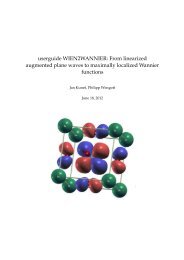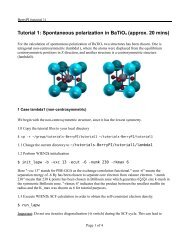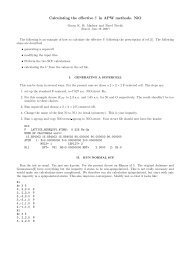A Package for calculating elastic tensors of cubic - WIEN 2k
A Package for calculating elastic tensors of cubic - WIEN 2k
A Package for calculating elastic tensors of cubic - WIEN 2k
- No tags were found...
Create successful ePaper yourself
Turn your PDF publications into a flip-book with our unique Google optimized e-Paper software.
Background theory <strong>for</strong> <strong>calculating</strong> <strong>elastic</strong>constants <strong>of</strong> hexagonal phases used in theHex-<strong>elastic</strong><strong>Package</strong> 1Morteza Jamal15 th Dec 2012Ghods City-Tehran-IranElastic constants are defined by means <strong>of</strong> a Taylor expansion <strong>of</strong> thetotal energy E(v,e) <strong>for</strong> the system, with respect to a small strain “e” <strong>of</strong> thelattice (v is the volume). In this <strong>Package</strong> we consider the hcp crystalstructure, which is spanned by three vectors ( √3a/2, -a/2, 0), ( 0, a, 0), and( 0, 0, c ). The Bravais lattice vectors are normally written in a matrix <strong>for</strong>m,i.e.,√3a/2 -a/2 0R= 0 a 00 0 c
E(v,e) = E(v 0 ,0) +v 0 [(∆ 1+ ∆ 2 ) e + ( C 11 + C 12 ) e 2 + o(e 3 )]The second type <strong>of</strong> distortion is a volume conserved distortion and lead toOrthorhombic symmetry and written as1+e 1 0 0 1+e 1 =(1+x/1-x) 1/20 1+e 2 0 1+e 2 =(1-x/1+x) 1/20 0 1and the energy <strong>for</strong> this distortion can be obtained asE(v,e) = E(v 0 ,0) +v 0 [ ( C 11 - C 12 ) x 2 + o(x 3 )]The third strain we have used is given by1 0 00 1 00 0 1+eThis strain changes C lattice parameter and keep the symmetry <strong>of</strong> thestrained lattice hexagonal and the energy <strong>for</strong> this distortion can be obtainedbyE(v,e) = E(v 0 ,0) +v 0 [(∆ 3 ) e + ( C 33 ) e 2 /2+ o(e 3 )]The fourth <strong>elastic</strong> constant, C55, is determined by means <strong>of</strong> a de<strong>for</strong>mation <strong>of</strong>the lattice, which produces an object with low symmetry. The de<strong>for</strong>mation iswritten as1 0 e0 1 0e 0 1And it leads to triclinic symmetry and the energy <strong>for</strong> this de<strong>for</strong>mation can bewritten asE(v,e) = E(v 0 ,0) +v 0 [(∆ 5 ) e + (2 C 55 ) e 2 + o(e 3 )]
Finally, the last strain we have used is volume conserved and keeps thesymmetry <strong>of</strong> the strained lattice hexagonal and can be written as1+e 1 0 0 1+e 1 =(1+x) - 1/30 1+e 2 0 1+e 2 =(1+x) - 1/30 0 1+ e 3 1+e 3 =(1+x) 2/3And the energy <strong>for</strong> this strain is given byE(v,e) = E(v 0 ,0) +v 0 [ ( C zz )/9 x 2 + o(x 3 )]AndC zz = C 11 + C 12 + 2C 33 - 4C 13In practice, to calculate <strong>elastic</strong> constants we fit E(v,e) to a polynomial <strong>of</strong>degree M and M changes from 2 till N-1 , N is number <strong>of</strong> data, and then<strong>elastic</strong> constants is computed by using second order derivative ( E”(e) ) <strong>of</strong>Polynomial fit ( E=E(v,e) ) <strong>of</strong> Energy vs. strains (e) at zero strain (e=0). Inthis situation we are able to check the sensitivity <strong>of</strong> our results (<strong>elastic</strong>constants) to the order <strong>of</strong> fit however final results are <strong>for</strong> a polynomial <strong>of</strong>degree 2 ( M=2) because we are in the regime <strong>of</strong> Hooke’s law.[1] L. Fast, J. M. Wills, B. Johansson and O. Eriksson, Phys. Rev. B 51,(1995).[2] D.C. Wallace, Solid State Phys. 25, 301 (1970)
















